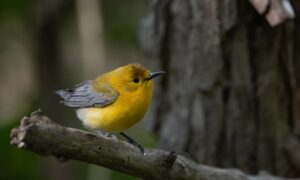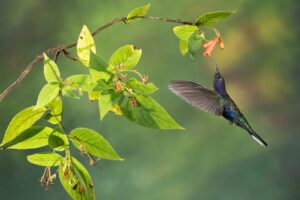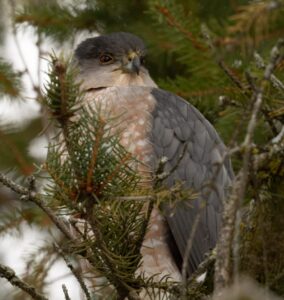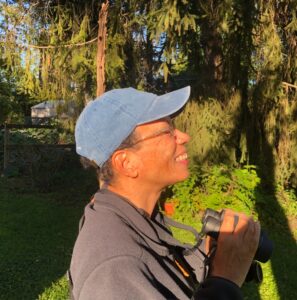What first inspired your involvement in birding?
I grew up on a former dairy farm in rural Connecticut. Our home backed up to a state park, so, essentially, we had no neighbors. My siblings and I spent our days playing outside, surrounded by nature. Early on, I was captivated by the birds that frequented our yard, especially the acrobatic Barn Swallows that nested in our barn. I spent hours watching them construct their mud nests and raise their young. I was hooked.

A Prothonotary Warbler perches atop a branch. Photo by April Campbell
Do you like to bird with others? Why or why not? What do you consider when going birding, either with people or individually?
I do like to bird with others, but I prefer to bird alone or in small groups. I find large groups intimidating and less helpful for learning and discovery. Unless you are at the very front of a large group, you are likely to miss the bird entirely. It’s also much harder to “slow bird” in a large group, as the goal is, more often than not, to see as many species as possible in a short amount of time.
Birding with a small group affords me the opportunity to get to know other birders better as people. Not everyone is interested in doing that, of course, so I try to gravitate to people who are open to birding with someone quite different from themselves. It’s not just about the birds; it’s also about building relationships. Safety is another issue I consider when birding. I will not bird alone in a remote park. I have been accosted in public spaces by people wanting to know what I was “doing.” Once, while birding alone in a suburban neighborhood, an elderly woman followed me for several blocks because she thought I was using my binoculars to choose homes to rob! This can be a difficult concept for many white birders to understand.

April captured this hummingbird while birding in Ecuador.
Photo by April Campbell
What has been difficult about this hobby and groups, events, and the overall community of birding or bird conservation for you?
I’ve been a member of Audubon in five different states and, until recently, I’ve been the only African American member. To be sure, I’m quite accustomed to being the lone raisin in the pudding, so to speak, but I had hoped by now the hobby would have grown far more diverse in both form and outlook. Change has occurred, but it’s been painfully slow. Over the years, I’ve met some fascinating and kind birders, but very rarely did any of them reach out to me as a person or suggest ways to involve more BIPOC birders. Often the focus is on “listing.” Listing has its place, but accumulating species numbers just for the sake of bragging rights smacks of yet another form of consumerism. I also think it teaches new birders to focus on numbers and the technology to obtain those numbers rather than the birds themselves. I think many new BIPOC birders would find this intimidating. I’m also cognizant of birding language. Denoting a bird as a “good” bird implies there are “bad” birds. Black birds often get a bad rap, too. I once listened to an Audubon lecture where the presenter announced, “We usually don’t think of black as beautiful.” These kinds of tone-deaf events sadden me.
Why, in your experience and opinion, do birders and birding circles and groups need to consider race in their work?
Our lives and attitudes are informed by our experiences, both negative and positive. One of my first memories as a child was of a brick being thrown through our front window by white boys yelling the n-word. My pet ducks and geese were slaughtered by two white men who disliked my father. Most African Americans have experienced similar or far worse atrocities in their lives. On top of these macroaggressions are the constant microaggressions experienced in our day-to-day lives. With this backdrop in mind and remembering this nation’s centuries-long history of chattel slavery and Jim Crow, white birders must understand that African Americans are not just white people with a permanent tan.
How do you see people effecting change for more racial inclusivity, belonging, and support in the outdoor recreation and birding spheres?
Building relationships of trust with traditionally marginalized groups is key. This takes time, courage, and a willingness to be vulnerable. Misunderstandings will occur, and that’s okay! It’s important for leaders in the birding community to seek out marginalized groups and not expect them to come to them no matter how welcoming they are. Forming a mentor list for BIPOC birders is an important goal. Mentors can make a dramatic difference in a BIPOC person’s life. Supporting independent BIPOC birding groups that interact with local Audubon chapters is another option. This allows BIPOC birders to operate within a safe space and still experience the world of birds with more seasoned birders. Urban birding should be a part of every Audubon chapter. Local chapters could dedicate several days a month for birding in Detroit, Flint, Benton Harbor, or Saginaw. Birds live in cities, too!

A Cooper’s Hawk scans the surroundings. Photo by April Campbell
Any advice for chapters of Michigan Audubon in how they can approach this work, this mindfulness, in their communities?
As I mentioned, building relationships of trust is paramount. But you can’t build those relationships without performing some inner work. “Outreach requires inreach.” By “inreach” I mean first recognizing that racism permeates all aspects of American society, including birding, and no one is “color blind.” White people as the dominant racial group are traditionally afforded certain privileges and power regardless of their social standing. Chapter leaders must first educate themselves and their white peers through reading and discussion groups in order to better understand the role that membership in the dominant groups plays in how they view the world and the “other.” There are several notable books that can aid in this journey: I highly recommend Deborah Irving’s book, Waking Up White, and Ruth King’s Mindful of Race: Transforming Racism from the Inside Out.
African Americans, on the other hand, must temper our wariness and mistrust and remain open to the possibility of change in both people and institutions. We must all set aside ego as we have much to learn from each other if we are willing to listen and make mistakes along the way. Forgiveness is one of the cornerstones of mindfulness. Forgiving oneself and others is also the gateway to freedom. I remain confident that if we strive hard enough, we will all one day be free…as a bird.

April Campell is a retired M.D., experienced birder and photographer, member, and volunteer for Michigan Audubon’s Diversity, Equity, and Inclusion Advisory Council.
This article appeared in the 2021 Fall Jack Pine Warbler.
You can also find a list of Diversity, Equity, and Inclusion Resources and Recommended Reading For Addressing Diversity and Race in Michigan Audubon Chapters that was curated by April for the recent JPW.

